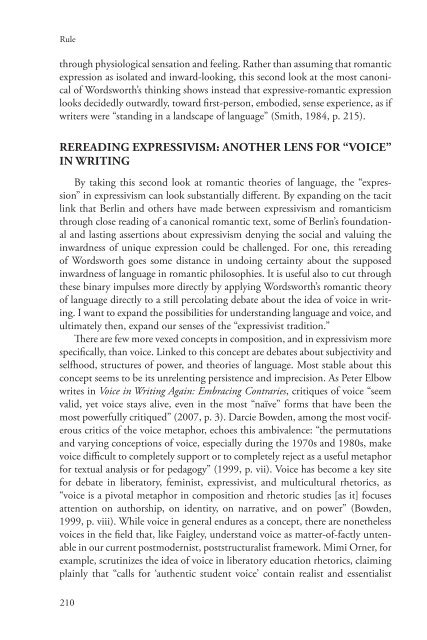Critical Expressivism- Theory and Practice in the Composition Classroom, 2014a
Critical Expressivism- Theory and Practice in the Composition Classroom, 2014a
Critical Expressivism- Theory and Practice in the Composition Classroom, 2014a
Create successful ePaper yourself
Turn your PDF publications into a flip-book with our unique Google optimized e-Paper software.
Rule<br />
through physiological sensation <strong>and</strong> feel<strong>in</strong>g. Ra<strong>the</strong>r than assum<strong>in</strong>g that romantic<br />
expression as isolated <strong>and</strong> <strong>in</strong>ward-look<strong>in</strong>g, this second look at <strong>the</strong> most canonical<br />
of Wordsworth’s th<strong>in</strong>k<strong>in</strong>g shows <strong>in</strong>stead that expressive-romantic expression<br />
looks decidedly outwardly, toward first-person, embodied, sense experience, as if<br />
writers were “st<strong>and</strong><strong>in</strong>g <strong>in</strong> a l<strong>and</strong>scape of language” (Smith, 1984, p. 215).<br />
REREADING EXPRESSIVISM: ANOTHER LENS FOR “VOICE”<br />
IN WRITING<br />
By tak<strong>in</strong>g this second look at romantic <strong>the</strong>ories of language, <strong>the</strong> “expression”<br />
<strong>in</strong> expressivism can look substantially different. By exp<strong>and</strong><strong>in</strong>g on <strong>the</strong> tacit<br />
l<strong>in</strong>k that Berl<strong>in</strong> <strong>and</strong> o<strong>the</strong>rs have made between expressivism <strong>and</strong> romanticism<br />
through close read<strong>in</strong>g of a canonical romantic text, some of Berl<strong>in</strong>’s foundational<br />
<strong>and</strong> last<strong>in</strong>g assertions about expressivism deny<strong>in</strong>g <strong>the</strong> social <strong>and</strong> valu<strong>in</strong>g <strong>the</strong><br />
<strong>in</strong>wardness of unique expression could be challenged. For one, this reread<strong>in</strong>g<br />
of Wordsworth goes some distance <strong>in</strong> undo<strong>in</strong>g certa<strong>in</strong>ty about <strong>the</strong> supposed<br />
<strong>in</strong>wardness of language <strong>in</strong> romantic philosophies. It is useful also to cut through<br />
<strong>the</strong>se b<strong>in</strong>ary impulses more directly by apply<strong>in</strong>g Wordsworth’s romantic <strong>the</strong>ory<br />
of language directly to a still percolat<strong>in</strong>g debate about <strong>the</strong> idea of voice <strong>in</strong> writ<strong>in</strong>g.<br />
I want to exp<strong>and</strong> <strong>the</strong> possibilities for underst<strong>and</strong><strong>in</strong>g language <strong>and</strong> voice, <strong>and</strong><br />
ultimately <strong>the</strong>n, exp<strong>and</strong> our senses of <strong>the</strong> “expressivist tradition.”<br />
There are few more vexed concepts <strong>in</strong> composition, <strong>and</strong> <strong>in</strong> expressivism more<br />
specifically, than voice. L<strong>in</strong>ked to this concept are debates about subjectivity <strong>and</strong><br />
selfhood, structures of power, <strong>and</strong> <strong>the</strong>ories of language. Most stable about this<br />
concept seems to be its unrelent<strong>in</strong>g persistence <strong>and</strong> imprecision. As Peter Elbow<br />
writes <strong>in</strong> Voice <strong>in</strong> Writ<strong>in</strong>g Aga<strong>in</strong>: Embrac<strong>in</strong>g Contraries, critiques of voice “seem<br />
valid, yet voice stays alive, even <strong>in</strong> <strong>the</strong> most “naïve” forms that have been <strong>the</strong><br />
most powerfully critiqued” (2007, p. 3). Darcie Bowden, among <strong>the</strong> most vociferous<br />
critics of <strong>the</strong> voice metaphor, echoes this ambivalence: “<strong>the</strong> permutations<br />
<strong>and</strong> vary<strong>in</strong>g conceptions of voice, especially dur<strong>in</strong>g <strong>the</strong> 1970s <strong>and</strong> 1980s, make<br />
voice difficult to completely support or to completely reject as a useful metaphor<br />
for textual analysis or for pedagogy” (1999, p. vii). Voice has become a key site<br />
for debate <strong>in</strong> liberatory, fem<strong>in</strong>ist, expressivist, <strong>and</strong> multicultural rhetorics, as<br />
“voice is a pivotal metaphor <strong>in</strong> composition <strong>and</strong> rhetoric studies [as it] focuses<br />
attention on authorship, on identity, on narrative, <strong>and</strong> on power” (Bowden,<br />
1999, p. viii). While voice <strong>in</strong> general endures as a concept, <strong>the</strong>re are none<strong>the</strong>less<br />
voices <strong>in</strong> <strong>the</strong> field that, like Faigley, underst<strong>and</strong> voice as matter-of-factly untenable<br />
<strong>in</strong> our current postmodernist, poststructuralist framework. Mimi Orner, for<br />
example, scrut<strong>in</strong>izes <strong>the</strong> idea of voice <strong>in</strong> liberatory education rhetorics, claim<strong>in</strong>g<br />
pla<strong>in</strong>ly that “calls for ‘au<strong>the</strong>ntic student voice’ conta<strong>in</strong> realist <strong>and</strong> essentialist<br />
210


















